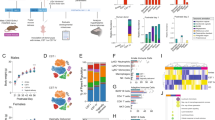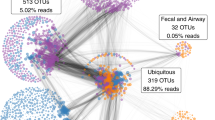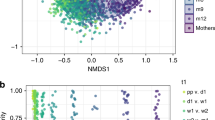Abstract
Exposure of newborns to the maternal vaginal microbiota is interrupted with cesarean birthing. Babies delivered by cesarean section (C-section) acquire a microbiota that differs from that of vaginally delivered infants, and C-section delivery has been associated with increased risk for immune and metabolic disorders. Here we conducted a pilot study in which infants delivered by C-section were exposed to maternal vaginal fluids at birth. Similarly to vaginally delivered babies, the gut, oral and skin bacterial communities of these newborns during the first 30 d of life was enriched in vaginal bacteria—which were underrepresented in unexposed C-section–delivered infants—and the microbiome similarity to those of vaginally delivered infants was greater in oral and skin samples than in anal samples. Although the long-term health consequences of restoring the microbiota of C-section–delivered infants remain unclear, our results demonstrate that vaginal microbes can be partially restored at birth in C-section–delivered babies.
This is a preview of subscription content, access via your institution
Access options
Subscribe to this journal
Receive 12 print issues and online access
$209.00 per year
only $17.42 per issue
Buy this article
- Purchase on Springer Link
- Instant access to full article PDF
Prices may be subject to local taxes which are calculated during checkout


Similar content being viewed by others
Accession codes
References
Dominguez-Bello, M.G. et al. Proc. Natl. Acad. Sci. USA 107, 11971–11975 (2010).
Olszak, T. et al. Science 336, 489–493 (2012).
Cox, L.M. et al. Cell 158, 705–721 (2014).
Thavagnanam, S., Fleming, J., Bromley, A., Shields, M.D. & Cardwell, C.R . Clin. Exp. Allergy 38, 629–633 (2008).
Pistiner, M., Gold, D.R., Abdulkerim, H., Hoffman, E. & Celedón, J.C. J. Allergy Clin. Immunol. 122, 274–279 (2008).
Huh, S.Y. et al. Arch. Dis. Child. 97, 610–616 (2012).
Sevelsted, A., Stokholm, J., Bønnelykke, K. & Bisgaard, H. Pediatrics 135, e92–e98 (2015).
Gibbons, L. et al. World Health Rep. 30, 1–31 (2010).
Finger, C. Lancet 362, 628 (2003).
Barber, E.L. et al. Obstet. Gynecol. 118, 29–38 (2011).
Moore, B. Lancet 2, 436–437 (1985).
Clemente, J.C. et al. Sci. Adv. 1, e1500183 (2015).
Knights, D. et al. Nat. Methods 8, 761–763 (2011).
Knights, D., Parfrey, L.W., Zaneveld, J., Lozupone, C. & Knight, R. Cell Host Microbe 10, 292–296 (2011).
Bäckhed, F. et al. Cell Host Microbe 17, 690–703 (2015).
Yatsunenko, T. et al. Nature 486, 222–227 (2012).
Pantoja-Feliciano, I.G. et al. ISME J. 7, 1112–1115 (2013).
Fardini, Y., Chung, P., Dumm, R., Joshi, N. & Han, Y.W. Infect. Immun. 78, 1789–1796 (2010).
Aagaard, K. et al. Sci. Transl. Med. 6, 237ra265 (2014).
Caporaso, J.G. et al. Nat. Methods 7, 335–336 (2010).
Rideout, J.R. et al. PeerJ 2, e545 (2014).
McDonald, D. et al. ISME J. 6, 610–618 (2012).
Faith, D.P. & Baker, A.M. Evol. Bioinform. Online 2, 121–128 (2006).
Lozupone, C. & Knight, R. Appl. Environ. Microbiol. 71, 8228–8235 (2005).
Langille, M.G. et al. Nat. Biotechnol. 31, 814–821 (2013).
Katoh, K. & Standley, D.M. Mol. Biol. Evol. 30, 772–780 (2013).
Acknowledgements
This work was partially supported by the C&D Research Fund (M.G.D.-B.), the US National Institutes of Health grant no. R01 DK090989 (M.G.D.-B), the Crohn's and Colitis Foundation of America grant no. 362048 (J.C.C.) and the Sinai Ulcerative Colitis: Clinical, Experimental & Systems Studies philanthropic grant (J.C.C.). Sequencing at the New York University Genome Technology Center was partially supported by the Cancer Center Support grant no. P30CA016087 at the Laura and Isaac Perlmutter Cancer Center. Computing was partially supported by the Department of Scientific Computing at the Icahn School of Medicine at Mount Sinai. We acknowledge the contribution of the students who participated in obtaining the samples and the metadata: S.M. Rodriguez, J.F. Ruiz, N. Garcia and J.L. Rivera-Correa. We also thank M.J. Blaser for discussions and critical comments, and three anonymous reviewers for their suggestions to improve this manuscript.
Author information
Authors and Affiliations
Contributions
M.G.D.-B. designed the study. M.G.D.-B., K.M.D.J.-L., J.I.R.-V. and K.M. collected and processed specimens. M.G.D.-B. sequenced and generated data. N.S., L.M.C., A.A., A.G., N.A.B., S.J.S., M.H. and J.C.C. performed experiments. M.G.D.-B., N.S., L.M.C., A.A., A.G., N.A.B., S.J.S., M.H., R.K. and J.C.C. analyzed data. M.G.D.-B. and J.C.C. drafted the manuscript. All authors reviewed the final manuscript.
Corresponding authors
Ethics declarations
Competing interests
New York University has filed a US patent application (number 62161549) related to methods for restoring the microbiota of newborns on behalf of M.G.D.-B.
Supplementary information
Supplementary Text and Figures
Supplementary Figures 1–10 and Supplementary Tables 1–4 (PDF 8461 kb)
Source data
Rights and permissions
About this article
Cite this article
Dominguez-Bello, M., De Jesus-Laboy, K., Shen, N. et al. Partial restoration of the microbiota of cesarean-born infants via vaginal microbial transfer. Nat Med 22, 250–253 (2016). https://doi.org/10.1038/nm.4039
Received:
Accepted:
Published:
Issue Date:
DOI: https://doi.org/10.1038/nm.4039
This article is cited by
-
Microbiome dysbiosis: a modifiable state and target to prevent Staphylococcus aureus infections and other diseases in neonates
Journal of Perinatology (2024)
-
Parental care contributes to vertical transmission of microbes in a skin-feeding and direct-developing caecilian
Animal Microbiome (2023)
-
Early-life respiratory infections and developmental immunity determine lifelong lung health
Nature Immunology (2023)
-
Should we modulate the neonatal microbiome and what should be the goal?
Microbiome (2022)
-
The gut microbiome of obese postpartum women with and without previous gestational diabetes mellitus and the gut microbiota of their babies
Diabetology & Metabolic Syndrome (2022)



